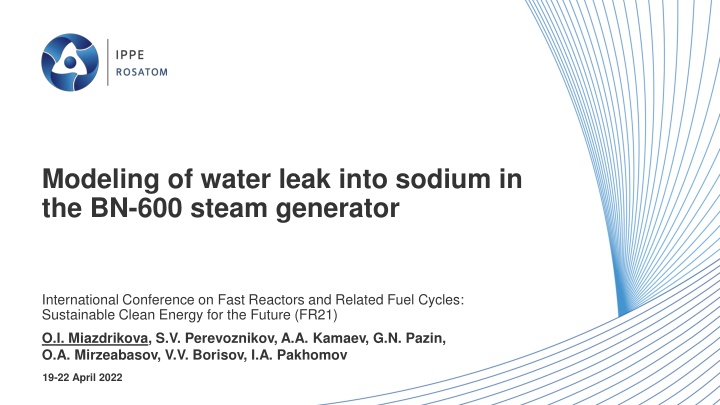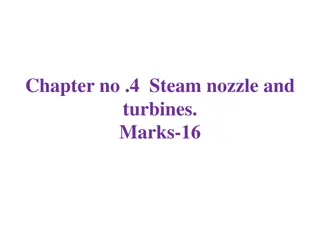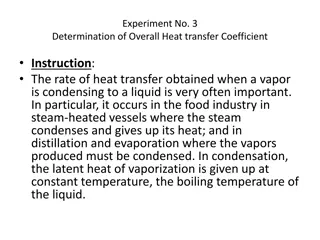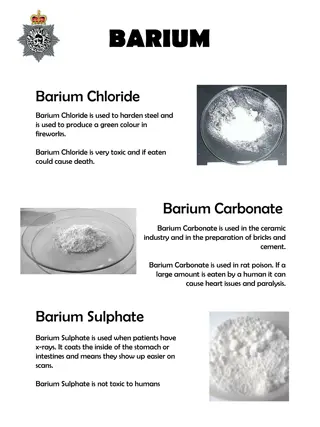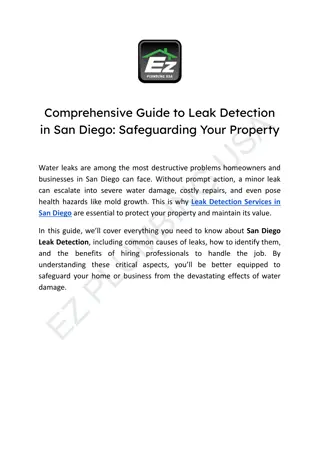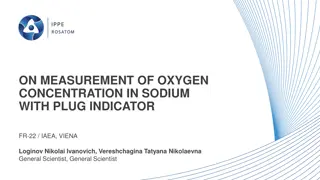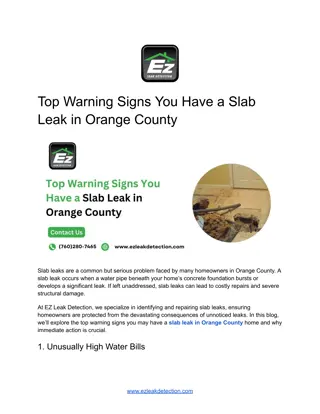Modeling Water Leak into Sodium in BN-600 Steam Generator
This paper discusses the modeling of a water leak into sodium in the BN-600 steam generator during a specific incident in 1982. It compares calculated data with leak detection system indications and analyzes hydrodynamic parameters in the second sodium circuit. The study utilized SLEAK and LLEAK-3C.1.0 codes to assess the efficiency of the steam generator protection system, providing valuable insights for the verification of physical and mathematical models. The incident analysis includes details on the steam generator characteristics, water entry into the sodium circuit, and post-accident findings from module inspection.
Download Presentation

Please find below an Image/Link to download the presentation.
The content on the website is provided AS IS for your information and personal use only. It may not be sold, licensed, or shared on other websites without obtaining consent from the author.If you encounter any issues during the download, it is possible that the publisher has removed the file from their server.
You are allowed to download the files provided on this website for personal or commercial use, subject to the condition that they are used lawfully. All files are the property of their respective owners.
The content on the website is provided AS IS for your information and personal use only. It may not be sold, licensed, or shared on other websites without obtaining consent from the author.
E N D
Presentation Transcript
Modeling of water leak into sodium in the BN-600 steam generator International Conference on Fast Reactors and Related Fuel Cycles: Sustainable Clean Energy for the Future (FR21) O.I. Miazdrikova, S.V. Perevoznikov, A.A. Kamaev, G.N. Pazin, O.A. Mirzeabasov, V.V. Borisov, I.A. Pakhomov 19-22 April 2022
Introducion The paper presents the results comparing the calculated data with the indications of water-to-sodium leak detection system and hydrodynamic parameters in the second sodium circuit, observed during the water-to-sodium leak incident in the superheater module of the BN-600 unit on January 19, 1982. The calculations were performed using SLEAK and LLEAK-3C 1.0 codes designed to analyze the efficiency of the steam generator protection system. The obtained data can be used for verification of physical and mathematical models in the SLEAK and LLEAK-3C 1.0 codes. 2
Steam generator of the BN-600 NPP and safety system in case of water leaks Location devices of water-to-sodium leak monitoring The scheme of the second sodium circuit BN-600 3
Description of the incident with leak in the superheater module NNP BN-600 on January 19, 1982 Characteristics of steam generator No. 5 at the time of leak: sodium temperature at SG inlet 492 C; sodium temperature at SG outlet 298 C; superheated steam pressure 11.2 MPa; superheated steam temperature 489 C; SG steam capacity 463 t/h. According to the results of the post-accident analysis, the amount of water that entered the second sodium circuit was estimated 20.3 kg. The results of the module inspection identified 7 heat exchange tubes of the steam generator with through faults. 4 * Y.M. Ashurko, R.P. Baklushin etc. Fast reactor operating experience gained in Russia: analysis of anomalies and abnormal operation cases. Unusual occurrences during LMFR OPERATION, IAEA- TECDOC-1180, IAEA, VIENNA, 2000, p. 117-144
Modelling of the incident using SLEAK and LLEAK-3C 1.0 codes Water flow rate and concentrations of hydrogen in sodium at the outlet of failed and non- failed sections with a small leak Calculated indications of the ISHIT and KAV-7 devices 5
Modelling of the incident using SLEAK and LLEAK-3C 1.0 codes Water/steam flow rate Pressure at the area of sodium-water reaction Sodium flow rate at the outlet of the non- failed SG section Water/Sodium flow rate at the failed SG section 6
The comparison between the post-accident analysis data and the calculation results using lleak -3c 1.0 code Pressure and sodium level in the ET Post-accident analysis LLEAK -3C 1.0 calculation, max value Parameter Increase of sodium flow rate at the outlet of the failed section, % 35 45 Increase of sodium flow rate through non-failed sections, % 10 7,5 Increase of sodium level in the ET, mm 250 267 In general, the hydrodynamic parameters derived the LLEAK-3C 1.0 code describe securely the processes in the second circuit of the BN-600 with a large water-to-sodium leak and do not contradict the data of the post-accident analysis of the incident. The results obtained confirm the correctness of the physical and mathematical models implemented in the LLEAK-3C 1.0 code: model of the sodium-water reaction, model of the rupture disk, the point model of the expansion tank, etc. 7
Conclusion The use of two codes SLEAK and LLEAK-3C 1.0 made it possible to simulate the processes that occurred in the second circuit of the BN-600 reactor in case of the water leak incident in the steam generator on January 19, 1982. The application of SLEAK code based on the small leak calculations helped to obtain a good match between the calculated data and the indications of IVA-1 in the failed section. The values of hydrodynamic parameters obtained using the LLEAK-3C1.0 code describe securely the processes in the second circuit NNP BN-600 with a large water-to-sodium leak and do not contradict the data of the retrospective analysis of the incident. The results of computational modelling of the real incident on the BN-600 confirm the correctness of the physical and mathematical models implemented in the SLEAK and LLEAK-3C 1.0 codes. 8
Thank you for your attention Olga Miazdrikova E-mail: okorzun@ippe.ru www.rosatom.ru 19.04.2022
